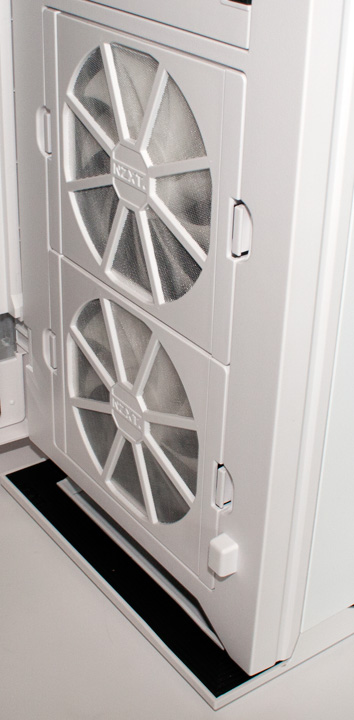NZXT H2 Classic Mid-Tower Chassis Review
Andy Ruffell / 13 years ago
ExteriorThe H2 is a medium sized chassis and comes in a choice of two colours; black or white. Today we have the white edition which should be of ample size for most systems sizing up at 215x466x520mm and weighing in at 8.9kg. The majority of the case is made from painted steel whilst some aspects of the case are made from plastic.
The right side of the case is a very simple affair with no window or ventilation holes. Just a simple white solid side. Behind this side panel is where we will see how much room is available for cable management a bit later on in the review.
The left side of the case is very much the same with a solid white door panel held on by thumbscrews.
On the top of the case is where we find a huge amount of buttons, switches and front panel connectors. This includes microphone and headphone audio jacks, a single USB 3.0 port, three USB 2.0 ports, fan controller with 3 settings and power and reset buttons on each end of the panel and are made from rubber as opposed to plastic.
Just behind the front panel connectors is a plastic panel which can be removed using the push button.
By taking this panel off it reveals a docking slot for a suitable hard drive using the SATA interface.
There is also a notice to inform you of the hot swap capability and that certain settings and hardware are needed to gain full functionality of this feature.
To the back of this hard drive docking station is another removable panel.
The plastic cover itself is magnetic and has four tiny magnets situated in the corners of the plate to make sure the panel sits evenly across the top of the case.
Once removed, it will reveal the ventilation area which can house up to a 140mm fan but sadly isn’t supplied with the case.
The front of the case includes a different type of material. It actually has an aluminium sheet which is silver on this version and a stealthy black on the black version to go with the rest of the styling. The door panel has a brushed effect and looks to be of extremely good quality.
Opening the door up reveals a thick padded layer which assists in keeping the case as quiet as possible.
The door shuts with the assistance of magnets.
The case has three optical drive bays of which include a simple, tool-less operation.
You simply push the black latch in and the cover pops out. You can then slide your relevant drives into place.
Below the optical drive bays are two 120mm fans which run at a comfortable 1200RPM.
The fan including cowling is completely removable and features white blades to match the rest of the chassis.
Also on the fan housing is a tiny PCB that makes for a simple removal process as opposed to disconnecting Molex or fan connectors.
The case has the second aspect of the fan removal system upon it. Once the fan makes contact with this plate, it will spin up, but as soon as it’s removed the fan will stop.
Behind the fan is where we get a first glimpse of the storage cage.
At the bottom of the case is a rubber platform that has the NZXT logo cut out. though it’s out of the way, it’s very effective placement.
Moving around to the rear of the case finds the USB 3.0 cable already pre-looped for you and another 120mm fan much like we saw on the front pre-installed. The rear I/O panel is also situated towards the very top of the case.
There are the usual seven expansion slots, of which each has a full ventilated black mesh cover to give the best airflow when not in use.
To the right of the expansion slots are two rubber grommets for passing watercooling tubing through and to match the rest of the aesthetics; are black.
The power supply is in its usual place at the bottom and gives us a view of the airflow features that NZXT have incorporated to give the best breathing space to your PSU.
There is also a removable dust filter which slides away from the bottom, towards the back of the case. This can be removed and cleaned with ease and slid back in afterwards.
Taking a look at the bottom of the chassis gives a view of the removable dust filters and what additions have been made to give the very best anti-vibration properties to the case in terms of its feet.














































